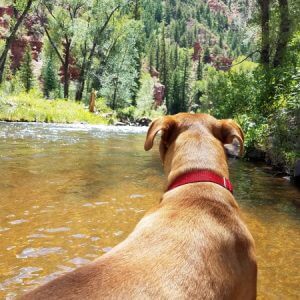Hiking In The Heat With Your Dog
Avid hikers know their limits and how far they can go on the trail, but our four-legged friends aren—t well versed in the signs of heat stroke and how far they can realistically push themselves. If you are taking your dog on a summer adventure, protect them from the heat!
 Know the Signs of Heat Stroke.
Know the Signs of Heat Stroke.
Rapid panting, lots of drooling, hot skin, twitching muscles, a dazed look, or vomiting are all indicators that a dog is suffering from heat stroke. If overheating happens on a trail, try to get your dog into a source of water or cool their paws by putting them into their water bowl. It—s always a good idea to seek medical attention from your regular vet after any heat stroke episode.
Not All Dogs Want to Drink Water.
How are they to know you planned an awesome hike today? If you have a dog that doesn—t normally drink much water at home, try adding water to their morning food—just enough to make their kibble slightly soggy. If you have a hard time getting your dog to drink water on the trail, try bringing ‘baited— water. Cut up low-sodium hot dogs or add a splash of low-sodium chicken broth to their water. You don—t need to add a lot- just enough to tempt them to drink.
The Best Hikes Are Planned.
When planning for your hike, do more than look up directions to the trailhead and check the weather- take into consideration the time of day you are hiking. Early morning or late evening are the coolest parts of the day and will be easiest on your pet—s paws. Also, try to hike somewhere that follows a water source. This way your pooch can get in and cool off if the mood strikes!

Consider Their Coat.
The long-haired dogs are well-suited for the Colorado winter, but they tend to overheat in the summer. Brush and bathe them regularly, as this removes dead hair and skin. Instead of fully shaving a long-hair coat, trim the hair around the groin and arm pits. Avoid the fruity-smelling shampoos as this will attract mosquitos! Black dogs will heat up much more quickly than a lighter-colored dog, so make sure to give your dark-furred companions more breaks in the shade.
Consider Their Age.
Allowing and encouraging your dog to move is a critical component of keeping him healthy in his old age, so don—t leave your old dog home when you hit the trail! Instead, plan the hike around him, even if that means going a little slower and easier than you—re used to. Start a preventative approach early on and give your dog supplements for joints and arthritis. Consider their rebound time- when they were young and spry, back-to-back days of hiking might have been the routine, but in their old age they should take a day break between hikes.
 Practice Proper Trail Etiquette.
Practice Proper Trail Etiquette.
Hiking trails in Colorado are shared-use areas, where horseback riders, bicyclers, trail runners, hikers, and dogs all have access to the same areas. When dog owners follow certain spoken and unspoken trail etiquette, hiking with our four-legged companions will not only be fun for us, but fun for everyone else too. Be a responsible pet-owner and make sure to always hike on dog-friendly trails. Yield to the right-of-way when encountering other hikers, dogs, or horses on the trail. Keep them on leash, control their barking, and most importantly, pick up their droppings and carry them out with you!


